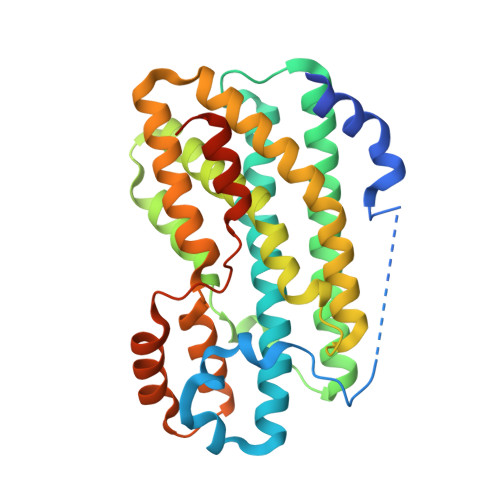Crystal structure of CmlI, the arylamine oxygenase from the chloramphenicol biosynthetic pathway.
Knoot, C.J., Kovaleva, E.G., Lipscomb, J.D.(2016) J Biol Inorg Chem 21: 589-603
- PubMed: 27229511
- DOI: https://doi.org/10.1007/s00775-016-1363-x
- Primary Citation of Related Structures:
5HYG, 5HYH - PubMed Abstract:
The diiron cluster-containing oxygenase CmlI catalyzes the conversion of the aromatic amine precursor of chloramphenicol to the nitroaromatic moiety of the active antibiotic. The X-ray crystal structures of the fully active, N-terminally truncated CmlIΔ33 in the chemically reduced Fe(2+)/Fe(2+) state and a cis μ-1,2(η (1):η (1))-peroxo complex are presented. These structures allow comparison with the homologous arylamine oxygenase AurF as well as other types of diiron cluster-containing oxygenases. The structural model of CmlIΔ33 crystallized at pH 6.8 lacks the oxo-bridge apparent from the enzyme optical spectrum in solution at higher pH. In its place, residue E236 forms a μ-1,3(η (1):η (2)) bridge between the irons in both models. This orientation of E236 stabilizes a helical region near the cluster which closes the active site to substrate binding in contrast to the open site found for AurF. A very similar closed structure was observed for the inactive dimanganese form of AurF. The observation of this same structure in different arylamine oxygenases may indicate that there are two structural states that are involved in regulation of the catalytic cycle. Both the structural studies and single crystal optical spectra indicate that the observed cis μ-1,2(η (1):η (1))-peroxo complex differs from the μ-η (1):η (2)-peroxo proposed from spectroscopic studies of a reactive intermediate formed in solution by addition of O2 to diferrous CmlI. It is proposed that the structural changes required to open the active site also drive conversion of the µ-1,2-peroxo species to the reactive form.
Organizational Affiliation:
Department of Biochemistry Molecular Biology and Biophysics and the Center for Metals in Biocatalysis, University of Minnesota, Minneapolis, MN, 55455, USA.

















